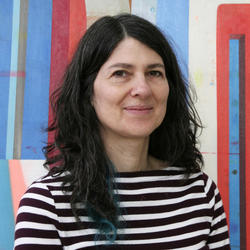Deborah Zlotsky

Deborah Zlotsky is a 2019 Guggenheim fellow and a 2012 and 2018 recipient of the New York Foundation for the Arts Fellowships in Painting. She is represented by Markel Fine Arts in New York and Robischon Gallery in Denver, and her drawings are in the curated flat files of Pierogi Gallery in New York.
Zlotsky has received residency fellowships at Yaddo, the MacDowell Colony, the Saltonstall Foundation, VCCA, Ragdale Foundation and the Bemis Center for Contemporary Art. Her work is in the collections of Nordstrom, Capital One, Progressive Insurance, the Waldorf Astoria, and the Borusan Contemporary Art Collection, among others. She has a BA in the History of Art from Yale University and an MFA in Painting and Drawing from the University of Connecticut.
Courses
Fall 2024 Courses
FOUND 1001-01
STUDIO:DRAWING
SECTION DESCRIPTION
Studio: Drawing is pursued in two directions: as a powerful way to investigate the world, and as an essential activity intrinsic to all artists and designers. As a primary mode of inquiry, drawing is a central means of forming questions and creating knowledge across disciplines. Through wide-ranging drawing approaches, students are prompted to work responsively and self-critically to embrace the unpredictable intersection of process, idea and media. To pursue these larger ideas, the studio becomes a laboratory of varied and challenging activities. Instructors introduce drawing as a dynamic two-dimensional record of sensory search, conceptual thought, or physical action. Students investigate materiality, imagined situations, idea generation, and the translation of the observable world. Formal and intellectual risks are encouraged during a sustained engagement with the possibilities of material, mark-making, perception, abstraction, performance, space and time. As students trust the drawing process, they become more informed about its uncharted potentials, and accept struggle as necessary and positive; they gain confidence in their own sensibilities.
Enrollment is limited to First-Year Undergraduate Students.
Major Requirement | BFA
FOUND 1001-06
STUDIO:DRAWING
SECTION DESCRIPTION
Studio: Drawing is pursued in two directions: as a powerful way to investigate the world, and as an essential activity intrinsic to all artists and designers. As a primary mode of inquiry, drawing is a central means of forming questions and creating knowledge across disciplines. Through wide-ranging drawing approaches, students are prompted to work responsively and self-critically to embrace the unpredictable intersection of process, idea and media. To pursue these larger ideas, the studio becomes a laboratory of varied and challenging activities. Instructors introduce drawing as a dynamic two-dimensional record of sensory search, conceptual thought, or physical action. Students investigate materiality, imagined situations, idea generation, and the translation of the observable world. Formal and intellectual risks are encouraged during a sustained engagement with the possibilities of material, mark-making, perception, abstraction, performance, space and time. As students trust the drawing process, they become more informed about its uncharted potentials, and accept struggle as necessary and positive; they gain confidence in their own sensibilities.
Enrollment is limited to First-Year Undergraduate Students.
Major Requirement | BFA